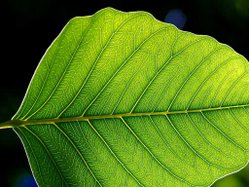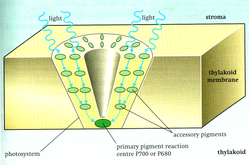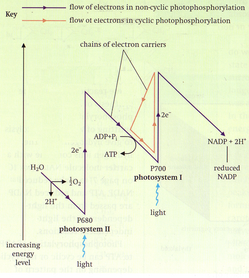|
PHOTOSYNTHESIS |
||
|
HOME BIOLOGY GEOGRAPHY HISTORY INDEX MUSIC FILMS THE BOAT SOLAR BOATS SPONSORS |
||
|
Photosynthesis is an important biochemical process in which plants, algae, and some bacteria harness the energy of sunlight to produce food. Ultimately, nearly all living things depend on energy produced from photosynthesis for their nourishment, making it vital to life on Earth. It is also responsible for producing the oxygen that makes up a large portion of the Earth's atmosphere. Organisms that produce energy through photosynthesis are called photoautotrophs. Half of all photosynthesis comes not from plants, but from bacteria and algae.
The leaf - primary site of photosynthesis in plants.
Plant photosynthesis
Plants are photoautotrophs, which means they are able to synthesize food directly from inorganic compounds using light energy, instead of eating other organisms or relying on material derived from them. This is distinct from chemoautotrophs that do not depend on light energy, but use energy from inorganic compounds.
The energy for photosynthesis ultimately comes from absorbed photons and involves a reducing agent, which is water in the case of plants, releasing oxygen as a waste product. The light energy is converted to chemical energy, in the form of ATP and NADPH, using the light-dependent reactions and is then available for carbon fixation. Most notably plants use the chemical energy to fix carbon dioxide into carbohydrates and other organic compounds through light-independent reactions. The overall equation for photosynthesis in green plants is:
Where n is defined according to the structure of the resulting carbohydrate. However, hexose sugars and starch are the primary products, so the following generalised equation is often used to represent photosynthesis:
More specifically, photosynthetic reactions usually produces an intermediate product, which is then converted to the final hexose carbohydrate products. These carbohydrate products are then variously used to form other organic compounds, such as the building material cellulose, as precursors for lipid and amino acid biosynthesis or as a fuel in cellular respiration. The latter not only occurs in plants, but also in animals when the energy from plants get passed through a food chain. In general outline, cellular respiration is the opposite of photosynthesis: glucose and other compounds are oxidised to produce carbon dioxide, water, and chemical energy. However, both processes actually take place through a different sequence of reactions and in different cellular compartments.
Plants capture light primarily using the pigment chlorophyll, which is the reason that most plants have a green color. The function of chlorophyll is often supported by other accessory pigments such as carotenoids and xanthophylls. Both chlorophyll and accessory pigments are contained in organelles (compartments within the cell) called chloroplasts. Although all cells in the green parts of a plant have chloroplasts, most of the energy is captured in the leaves. The cells in the interior tissues of a leaf, called the mesophyll, contain about half a million chloroplasts for every square millimeter of leaf. The surface of the leaf is uniformly coated with a water-resistant, waxy cuticle, that protects the leaf from excessive evaporation of water as well as decreasing the absorption of ultraviolet or blue light to reduce heating. The transparent, colourless epidermis layer allows light to pass through to the palisade mesophyll cells where most of the photosynthesis takes place. Photosynthesis in algae and bacteria
Algae range from multicellular forms like kelp to microscopic, single-celled organisms. Although they are not as complex as land plants, photosynthesis takes place biochemically the same way. Like plants, algea have chloroplasts and chlorophyll, but various accessory pigments are present in some algae, resulting in a wide variety of colours. All algae produce oxygen, and many are autotrophic. However, some are heterotrophic, relying on materials produced by other organisms.
Photosynthetic bacteria do not have chloroplasts. Instead, photosynthesis takes place directly within the cell. The cyanobacteria contain chlorophyll and oxygen, in the same way that chloroplasts do, in fact chloroplasts are now considered to have evolved from cyanobacteria by endosymbiosis. The other photosynthetic bacteria have a variety of different pigments, called bacteriochlorophylls, and do not produce oxygen.
A photosystem: a light-harvesting cluster of photosynthetic pigments in a chloroplast thylakoid membrane
Molecular productionLight to chemical energy
The light energy is converted to chemical energy using the light-dependent reactions. The products of the light dependent reactions are ATP from photophosphorylation and NADPH from photoreduction. Both are then utilized as an energy source for the light-independent reactions.
Z schemeIn plants, the light-dependent reactions occur in the thylakoid membranes of the chloroplasts and use light energy to synthesize ATP and NADPH. The photons are captured in the antenna complexes of photosystem I and II by chlorophyll and accessory pigments (see diagram at right). When a chorophyll a molecule at a photosystem's reaction center absorbs energy, an electron is excited and transferred to an electron-acceptor molecule through a process called Photoinduced charge separation. These electrons are shuttled through an electron transport chain that initially functions to generate a chemiosmotic potential across the membrane, the so called Z-scheme shown in the diagram. An ATP synthase enzyme uses the chemiosmotic potential to make ATP during photophosphorylation while NADPH is a product of the terminal redox reaction in the Z-scheme. Water photolysis
The NADPH is the main reducing agent in chloroplasts, providing a source of energetic electrons to other reactions. Its production leaves chlorophyll with a deficit of electrons (oxidized), which must be obtained from some other reducing agent. The excited electrons lost from chlorophyll in photosystem I are replaced from the electron transport chain by plastocyanin. However, since photosystem II includes the first steps of the Z-scheme, an external source of electrons is required to reduce its oxidized chlorophyll a molecules. This role is played by water during a reaction known as photolysis and results in water being split to give electrons, oxygen and hydrogen ions. Photosystem II is the only known biological enzyme that carries out this oxidation of water. Initially, the hydrogen ions from photolysis contribute to the chemiosmotic potential but eventually they combine with the hydrogen carrier molecule NADP+ to form NADPH. Oxygen is a waste product of photosynthesis but it has a vital role for all organisms that use it for cellular respiration. Oxygen and photosynthesis
With respect to oxygen and photosynthesis, there are two important concepts.
Bacterial variations
The concept that oxygen production is not directly associated with the fixation of carbon dioxide was first proposed by Cornelis Bernadus van Neil in the 1930s, who studied photosynthetic bacteria. Aside from the cyanobacteria, bacteria only have one photosystem and use reducing agents other than water. They get electrons from a variety of different inorganic chemicals including sulfide or hydrogen, so for most of these bacteria oxygen is not produced.
Others, such as the halophiles (an Archeae) produced so called purple membranes where the bacteriorhodopsin could harvest light and produce energy. The purple membranes was one of the first to be used to demonstrate the chemiosmotic theory: light hit the membranes and the pH of the solution that contained the purple membranes dropped as protons were pumping out of the membrane. Carbon Fixation
The fixation of carbon dioxide is a light-independent process in which carbon dioxide combines with a five-carbon sugar, ribulose bisphosphate (RuBP), to give two molecules of a three-carbon compound, glycerate 3-phosphate (GP). This compound is also sometimes known as 3-phosphoglycerate (PGA). GP, in the presence of ATP and NADPH from the light-dependent stages, is reduced to glyceraldehyde 3-phosphate (G3P). This product is also referred to as 3-phosphoglyceraldehyde (PGAL) or even as triose phosphate (a three-carbon sugar). This is the point at which carbohydrates are produced during photosynthesis. Some of the triose phosphates condense to form hexose phosphates, sucrose, starch and cellulose or are converted to acetylcoenzyme A to make amino acids and lipids. Others go on to regenerate RuBP so the process can continue (see Calvin Cycle).
The 'Z-scheme' of electron flow in light-dependent reactions
Discovery
Although some of the steps in photosynthesis are still not completely understood, the overall photosynthetic equation has been known since the 1800s.
Jan van Helmont began the research of the process in the mid-1600s when he carefully measured the mass of the soil used by a plant and the mass of the plant as it grew. After noticing that the soil mass changed very little, he hypothesized that the mass of the growing plant must come from the water, the only substance he added to the potted plant. This was a partially accurate hypothesis - much of the gained mass also comes from carbon dioxide as well as water. However, this was a signalling point to the idea that the bulk of a plant's biomass comes from the inputs of photosynthesis, not the soil itself.
Joseph Priestley, a chemist and minister, discovered that when he isolated a volume of air under an inverted jar, and burned a candle in it, the candle would burn out very quickly, much before it ran out of wax. He further discovered that a mouse could similarly "injure" air. He then showed that the air that had been "injured" by the candle and the mouse could be restored by a plant.
In 1778, Jan Ingenhousz, court physician to the Austrian Empress, repeated Priestley's experiments. He discovered that it was the influence of sun and light on the plant that could cause it to rescue a mouse in a matter of hours.
In 1796, Jean Senebier, a French pastor, showed that CO2 was the "fixed" or "injured" air and that it was taken up by plants in photosynthesis. Soon afterwards, Nicolas-Théodore de Saussure showed that the increase in mass of the plant as it grows could not be due only to uptake of CO2, but also to the incorporation of water. Thus the basic reaction by which photosynthesis is used to produce food (such as glucose) was outlined.
Modern scientists built on the foundation of knowledge from those scientists centuries ago and were able to discover many things.
Cornelius Van Niel made key discoveries explaining the chemistry of photosynthesis. By studying purple sulfur bacteria and green bacteria he was the first scientist to demonstrate that photosynthesis is a light-dependent redox reaction, in which hydrogen reduces carbon dioxide.
Further experiments to prove that the oxygen developed during the photosynthesis of green plants came from water, were performed by Robert Hill in 1937 and 1939. He showed that isolated chloroplasts give off oxygen in the presence of unnatural reducing agents like iron oxalate, ferricyanide or benzoquinone after exposure to light. The Hill reaction is as follows:
where A is the electron acceptor. Therefore, in light the electron acceptor is reduced and oxygen is evolved. Samuel Ruben and Martin Camen used radioactive isotopes to determine that the oxygen liberated in photosynthesis came from the water. Melvin Calvin and his partner Benson were able to puzzle out each stage in the dark or light-independent phase of photosynthesis, known as the Calvin Cycle. A Nobel Prize winning scientist, Rudolph A. Marcus, was able to discover the function and significance of the electron transport chain. Bioenergetics of photosynthesis
Photosynthesis is a physiological phenomenon that coverts solar energy into photochemical energy. This physiological phenomenon may be described thermodynamically in terms of changes in energy, entropy and free energy. The energetics of photosynthesis, driven by light, causes a change in entropy that in turn yields a usable source of energy for the plant.
The following chemical equation summarizes the products and reactants of photosynthesis in the typical green photosynthesizing plant:
With the presence of solar energy, the plant has a usable source of energy, which is termed the free energy (F) of the system. However, thermal energy is not completely interconvertible, which means that the character of the solar energy may lead to the limited convertibility of it into forms that may be used by the plant. This relates back to the work of Josiah Willard Gibbs: the change in free energy (ΔF) is related to both the change in entropy (ΔS) and the change in enthalpy (ΔH) of the system (Rabinowitch).
Overall, in conjunction with the oxidation-reduction reaction nature of the photosynthesis equation, and the interrelationships between entropy and enthalpy, energy in a usable form will be produced by the photosynthesizing green plant. Factors affecting photosynthesis
There are three main factors affecting photosynthesis and several corollary factors. The three main are:
Light intensity (Irradiance), wavelength and temperature
In the early 1900s F.F. Blackman investigated the effects of light intensity (irradiance) and temperature on the rate of photosynthesis. At constant temperature the rate of photosynthesis varies with irradiance, initially increasing as the irradiance increases. However at higher irradiance this relationship no longer holds and the rate of photosynthesis reaches a plateau. The effect on the rate of photosynthesis of varying the temperature at constant irradiance can be seen in image to the left. At high irradiance the rate of photosynthesis increases as the temperature is increased over a limited range. At low irradiance, increasing the temperature has little effect on the rate of photosynthesis. These two experiments illustrate vital points: firstly, from research it is known that photochemical reactions are not generally affected by temperature.
However, these experiments clearly show that temperature affects the rate of photosynthesis, so there must be two sets of reactions in the full process of photosynthesis. These are of course the light-dependent 'photochemical' stage and the light-independent, temperature-dependent stage. Secondly, Blackman's experiments illustrate the concept of limiting factors. Another limiting factor is the wavelength of light. Cyanobacteria which reside several metres underwater cannot receive the correct wavelengths required to cause photoinduced charge separation in conventional photosynthetic pigments. To combat this problem a series of proteins with different flourescent pigments surround the reaction centre. This unit is called a phycobilisome.
Carbon dioxide
As carbon dioxide concentrations rise the rate at which sugars are made by the light-independent reactions increases until limited by other factors. One reason for this is that RuBisCO, the enzyme fixing the carbon dioxide in the light-dependent reactions, has a binding affinity for both carbon dioxide and oxygen. Thus, an increase in the concentration of carbon dioxide increases the probability of RuBisCO fixing carbon dioxide instead of oxygen.
A reduced RuBisCO oxygenase activity is advantageous to plants for several reasons.
The salvaging pathway for the products of RuBisCO oxygenase activity is more commonly known as photorespiration since it is characterised by light dependent oxygen consumption and the release of carbon dioxide.
Corollary factors
References
Govindjee. Bioenergetics of Photosynthesis. New York: Academic Press, 1975. Gregory, R.P.F. Biochemistry of Photosynthesis. Belfast: Universities Press, 1971. Rabinowitch, Eugene and Govindjee. Photosynthesis. New York: John Wiley & Sons, Inc., 1969.
LINKS:
|
||
|


